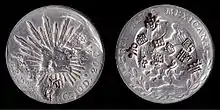Chop marks on coins
Chop marks on coins are Chinese characters stamped or embossed onto coins by merchants in order to validate the weight, authenticity and silver content of the coin. Depending on particular technique coins said to have been "chopmarked", "countermarked" and "counterstamped".[1]

Starting with the 18th century, a number of European, American and Japanese silver coins (generically known as the trade dollar) began circulating in the Far East. Each merchant's firm had its own mark and, after heavy circulation, the design of the coin became completely obliterated by the chop marks.[2]
Chop marks were also used on copper-alloy Chinese tokens from the province of Jiangsu at the time of the Taiping Rebellion, these tokens were usually issued by local authorities and could only be used to pay local merchants, tax collectors, local banks, and other local businesses during this period.[3]
The practice lasted until China demonetized the silver coins in 1933.[4]
See also
- Overstrike (numismatics) — where a new design is struck over an existing coin
- Countermark
- Counterfeit
- Punch-marked coins]]
Further reading
- C.J. Gullberg, Chopmarked Coins - A History. The Silver Coins Used in China 1600-1935 (iAsure Group, 2014).
References
- Chop Chop: Quick Guide to Chopmarks, Countermarks and Counterstamps
- VanRyzin, Robert R. (2012-04-01). U.S. Coins Close Up: Tips to Identifying Valuable Types and Varieties. F+W Media, Inc. p. 240. ISBN 1440229848.
- "Chinese Tokens – 中國代用幣。". Gary Ashkenazy / גארי אשכנזי (Primaltrek – a journey through Chinese culture). 16 November 2016. Retrieved 11 May 2018.
- Herbert, Alan (2011-02-28). Coin Clinic 2: 1,001 More Frequently Asked Questions. Krause Publications. ISBN 1440225184.